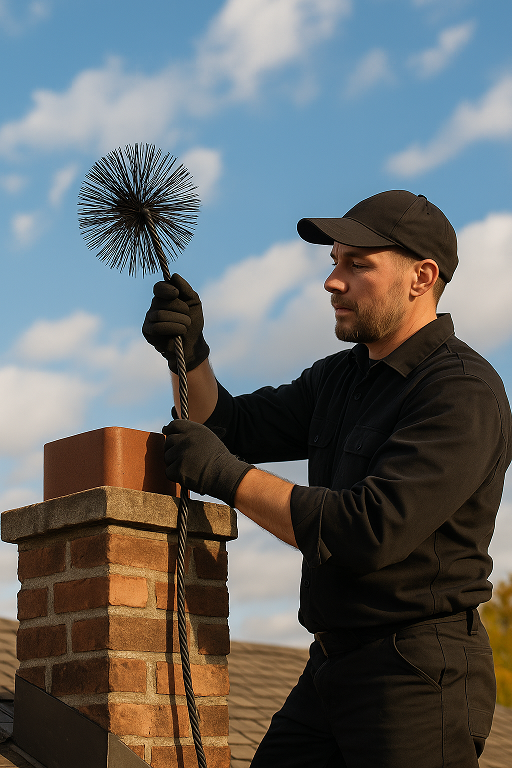If you own a home in Indianapolis and have a fireplace or wood stove, there’s one part of your chimney system you might not be thinking about but absolutely should: the chimney liner.
You don’t see it, hear it, or interact with it directly, but this hidden layer inside your chimney plays a huge role in fire prevention and home safety. In fact, not having a proper chimney liner (or having a damaged one) can put your entire house at risk. Let’s break it down in simple terms so you understand what a chimney liner in Indianapolis does, why it matters in local homes, and how to make sure your liner is doing its job.
What Is a Chimney Liner and Why Should You Care?
Think of a chimney liner as your chimney’s “inner skin.” It lines the inside of the flue (the passage that carries smoke up and out) and keeps intense heat, smoke, and gases from coming into direct contact with the chimney walls.
Here’s why that matters:
- It protects your home’s structure from heat that can crack bricks and mortar.
- It improves airflow, helping your fireplace or stove run efficiently.
- It prevents carbon monoxide and smoke from seeping into your house.
- And most importantly it helps prevent chimney fires.
Indianapolis homes, especially those in older neighborhoods like Irvington or Broad Ripple, often have aging chimneys. Many of these were built without liners or with clay liners that have deteriorated over time. That means now is the perfect time to check yours.
Why Chimney Liners Matter More Than You Think
Let’s get real chimney fires don’t usually look like explosions in the movies. Many are slow-burning, hidden behind your walls, and can go unnoticed until it’s too late. A damaged or missing liner lets flammable creosote build up or heat transfer through chimney walls, both of which can start a fire.
Here’s a quick table that shows how a chimney liner (or the lack of one) affects safety:
| Condition | What Can Happen | Risk Level |
| No liner at all | Direct heat to masonry, risk of house fire | Very High |
| Cracked or damaged liner | Heat leaks, creosote buildup, gas leaks | High |
| Properly installed liner | Safe venting, reduced fire risk | Safe & Efficient |
“Most chimney fires we see are caused by lack of maintenance or missing liners. It’s one of the simplest safety upgrades a homeowner can make.”
Local Chimney Inspector, Indianapolis
Key Features of a Chimney Liner
If you’re considering upgrading or installing a liner in your Indianapolis home, here are the key features to know:
- Heat Resistance: Chimney liners are built to handle extreme temperatures from wood or gas fires.
- Corrosion Protection: They block acidic smoke from eating away at your brickwork.
- Flexible or Rigid Options: Depending on your chimney shape and appliance, liners come in different formats.
- Custom Fit: A professional will size your liner to match your fireplace or stove perfectly.
- Material Choices: Options include clay tile (older style), stainless steel (modern standard), and aluminum (for certain gas appliances).
If you’re investing in safety, stainless steel liners are the go-to for most Indianapolis homeowners they last longer, resist corrosion, and are easy to maintain.
Chimney Liner Cost in Indianapolis
Let’s talk dollars. Chimney liner installation isn’t dirt cheap but it’s way more affordable than chimney repairs or fire damage.
Here’s a general idea of the cost range in Indianapolis:
| Type of Liner | Estimated Installed Cost | Best Use Case |
| Clay Tile | $1,500 – $3,000 | Original construction, budget-friendly |
| Stainless Steel (Rigid) | $2,000 – $4,000 | Long-term durability, wood-burning use |
| Stainless Steel (Flexible) | $1,800 – $3,500 | Older chimneys or curved flues |
| Aluminum | $800 – $1,800 | Gas appliances with lower heat output |
If your chimney is particularly tall or hard to access, the price might go up a bit. Still, it’s a solid investment especially considering many liners come with lifetime warranties when installed by certified pros.
Why Indianapolis Homes Specifically Need Chimney Liners
Here’s the thing Indianapolis weather can be rough on chimneys. Between freeze-thaw cycles in winter, humid summers, and aging construction, chimneys here take a beating.
Common challenges in Indy homes include:
- Cracked flues in older properties from the 1920s to 1970s
- Moisture damage from heavy spring rains
- Creosote buildup from frequent wood burning in winter
- Unlined chimneys in homes built before modern codes
And if you’ve converted a wood-burning fireplace to gas? You definitely need a properly sized liner for safe venting something older homes often lack.
Safety First: What Happens If You Skip the Liner?
Skipping a chimney liner (or ignoring a damaged one) might save money now but it’s a gamble with some serious risks:
- House fire from overheated walls or creosote ignition
- Carbon monoxide poisoning from improper exhaust venting
- Expensive repairs down the line from moisture and structural damage
- Home insurance issues if fire damage is traced to improper chimney use
Bottom line? It’s not worth skipping. Chimney liners might be out of sight, but they should never be out of mind.
Final Thoughts: A Smart Safety Move for Every Indianapolis Home
Fireplaces and stoves bring comfort, warmth, and charm to any Indianapolis home but only if they’re safe. A chimney liner is one of the most essential fire prevention features you can install, and it doesn’t just protect your chimney it protects your home, your family, and your peace of mind.
If you’re not sure whether your liner is intact or even exists, schedule an inspection. It takes just a short visit to know for sure and could be the difference between a cozy fire and a major disaster.
Read More: Chimney Sweep
